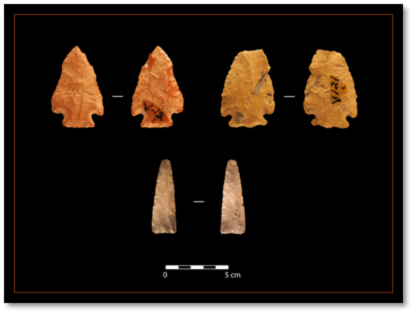The John Henry Collection
John Henry—a native of Danville, Illinois—has spent his life documenting Illinois and Indiana archaeology.
Henry developed an interest in archaeology and history after discovering stone tools as a young man. This interest, and his enjoyment from sharing his discoveries, has never ceased. In 1963, Henry and Al Nichols published “Paleo-Points from Vermilion County, Illinois” (Illinois Archaeological Survey Bulletin), often cited because it calls attention to use of glacial moraines by early populations, and one of few such articles about Vermillion County.
Having lived on both sides of the Wabash River and continuing to study history and prehistory, John Henry has made contributions to both Illinois and Indiana archaeology. He has made significant contributions to documenting the cultural history of the Wabash Valley. His contributions to Indiana include the donation of his archaeological collections from sites in Indiana to the Glenn Black Lab.

John Henry was one of the founding members of the Illinois Association for Advancement of Archaeology (IAAA), serving on the first board of directors, with Ferrel Anderson (President), Denzil Stephens (First Vice President), Jerry Elliston (Second Vice President), Glen Hanning (Secretary–Treasurer), and Gene Gray (Editor). Prior to the formation of the IAAA, John Henry and other founding members were invited by the Illinois Archaeological Survey (IAS) to join the short-lived Council For Illinois Archaeology. In a letter dated 21 June 1961, the late Joseph Caldwell, then Head Curator of Anthropology at the Illinois State Museum, invited John to join the council, “At the last meeting of the Illinois Archaeological Survey, it was suggested that we invite the most esteemed amateur archaeologists in this State to form a Council For Illinois Archaeology.”
John Henry and Al Nichols recorded more than 300 sites in the Danville area, plotting site locations on USGS topographic quadrangles and systematically collecting, labeling, and storing not only points and pottery but also debitage. In 1974, John assisted researchers from UIUC with their investigation of Vermilion County during the Historic Sites Survey. At that time, many of his sites were entered into the IAS site files, which is the principal documentation of known archaeological sites in the state. Henry directed archaeologists to the Collins site, an important Middle Mississippian mound and town complex. More recently, he provided site location and background information to ISAS archaeologists working on the Danville Beltline project.
In 2004, John Henry received the IAS Distinguished Amateur Award, presented to him by Brad Koldehoff.
In 2003, Henry donated his entire Danville-area collection to the University of Illinois. “In my estimate, the donation of his large collection of surface artifacts from Vermilion County to the Illinois State Archaeological Survey (ISAS) at the University of Illinois is likely to be one of his most enduring contributions,” said Koldehoff.
This significant collection of more than 1,000 artifacts is exceptionally documented. Vermilion County, like many eastern Illinois counties is rich in archaeological sites, but few investigations have been conducted. The curation of the well-documented John Henry collection by ISAS preserves a small but important segment of this county’s prehistory. The collection takes on greater significance when considering the destructive effects of modern agriculture on the archaeological record. The John Henry collection was gathered during the 1950s and 1960s, well before conservation tillage, when deep plowing not only turned up countless artifacts but also destroyed the context in which those artifacts had been deposited. Many shallowly buried sites have been damaged or destroyed by decades of plowing and erosion. Plowzone artifacts are the only remnants of these sites, and the vast majority of these artifacts were picked up decades ago by farmers, artifact collectors, and amateur archaeologists. If these private/amateur collections are not documented or curated at public institutions a substantial portion of the prehistoric record will be lost forever.
Dr. Emerson, Director of the Archaeological Survey, in praising the importance of Mr. Henry’s donation, said, “Those of us who are concerned with the long-term preservation of Illinois’s 10,000 years of history owe a considerable debt to dedicated collectors like Mr. Henry, who not only recovered but documented these artifacts from a little studied portion of the state, and who, furthermore, through his donation to ISAS, saw to the safeguarding of this information for future generations.”